Remarks of Commissioner Michael V. Dunn
National Grain and Feed Association’s 111th Annual Meeting – San Francisco, CA
March 20, 2007
Thank you, Kendall.
I am happy to be here today in San Francisco. I would like to specially thank Kendall and Todd Kemp for inviting me to come here.
I would like to make my own hedge exemption and say that my comments are my own, and do not necessarily reflect the views of any other Commissioner, or the Commission itself.
The CFTC came from the world of agriculture, and in a very real sense, the agricultural community remains the Commission’s strongest constituency. It is an exciting area of the Commission’s work, and, as Chair of the Agricultural Advisory Committee, I am grateful to be the Commission’s representative to the agricultural community.
Today, I would like to share some thoughts on issues facing the Commission that are relevant to your members.
I had a lot of help in preparing this presentation from our wonderful staff. I would especially like to thank John Fenton, Don Heitman, Bill Kokontis, and Dave Kass, David Amato and David Fickert from our Division of Market Oversight for their help.
NYBOT Update and Electronic Trading
Electronic trading continues play an ever larger role in the marketplace. On February 2, 2007, the New York Board of Trade (NYBOT) joined the fray, launching side-by-side trading for the NYBOT physical commodity contracts, using the Intercontinental Exchange’s (ICE) electronic trading platform. Commodities offered include cocoa, cotton, coffee, orange juice, and sugar.
This means today that virtually the entire suite of U.S. traded agricultural futures products has gone electronic over the past two years, bringing new users and new money into the markets. The electronic screens garner ever greater volume.
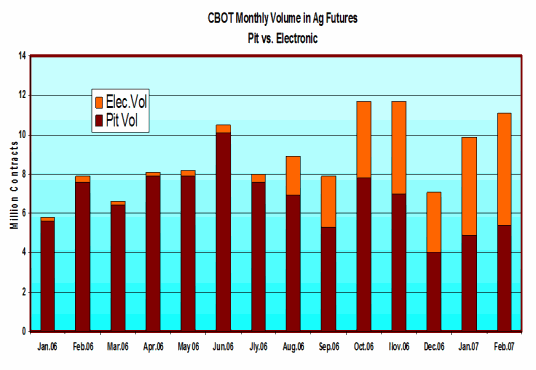
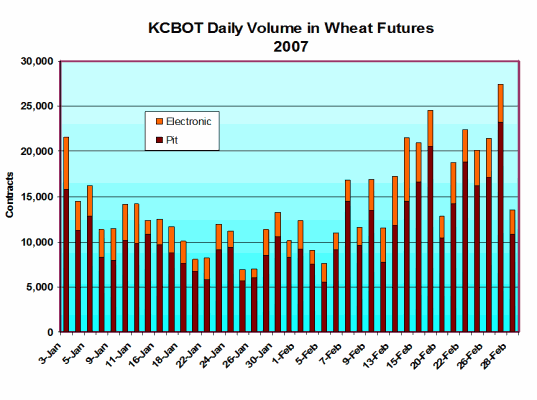
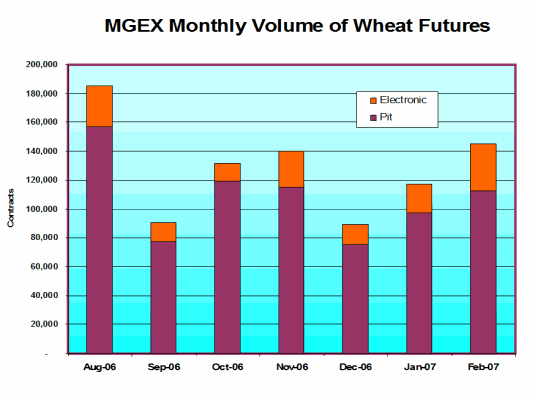
All of these exchanges have continued to see growth in the portion of their contracts traded electronically.
Last month the New York Board of Trade (NYBOT) became the latest exchange to go electronic. This slide shows the daily contract totals since electronic trading began.
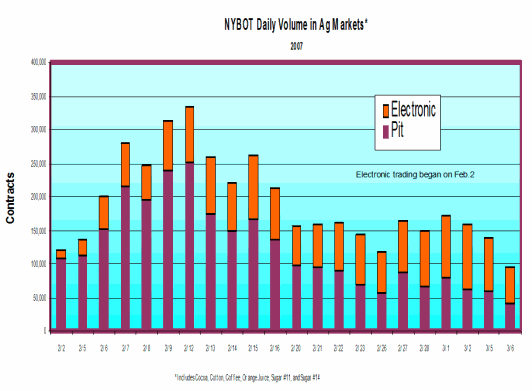
Because electronic trading only recently began, this chart is denominated in days rather than months or years as the other charts were. But the point is clear, electronic trading has accounted for a significant portion of trading at the NYBOT, as well.
I have not shown any statistics for the Chicago Mercantile Exchange because electronic trading of its agricultural products still has not really caught on. As of February, about 75 percent of all futures and options trading on U.S. commodities markets is executed electronically.
Corn / Ethanol
As many of you know Ethanol has transformed the grain markets by introducing significant additional demand for the U.S. corn crop resulting in high prices for producers, and concerns for processors about availability and cost.
Although not significantly traded itself in futures markets, ethanol production has had a substantial impact on agricultural markets.
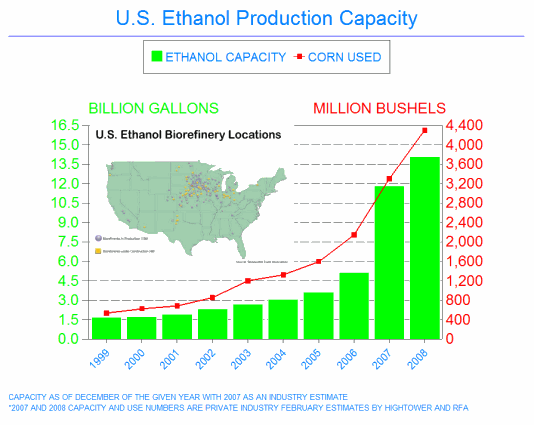
The U.S. ethanol capacity at the end of 2006 was approximately 5.1 billion gallons and it is expected to rise to 11.6 billion gallons by the end of 2007 for a 110% increase.
Capacity is expected to rise another 21% by the end of 2008 to 14.1 billion gallons. It is estimated that 2.1 billion bushels of corn will be used in 2006, 3.3 billion bushels in 2007, and 4.3 billion bushels in 2008.
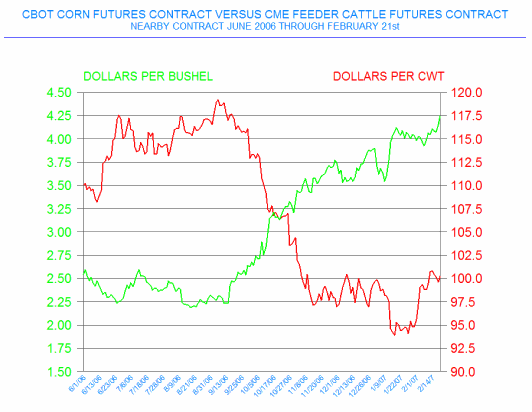
Due to the huge increase in demand for corn, prices of all the major grains have risen sharply. This means increased feed prices for livestock producers. Due to increased feed costs, demand for replacement feeder cattle has fallen, and consequently feeder cattle prices have declined significantly as well, although they have recovered somewhat recently.
Ultimately, this along with the weather this past year has led to tightness in the beef market. Feed costs have risen to the point where producers are substituting wheat and dried distillers grain for corn.
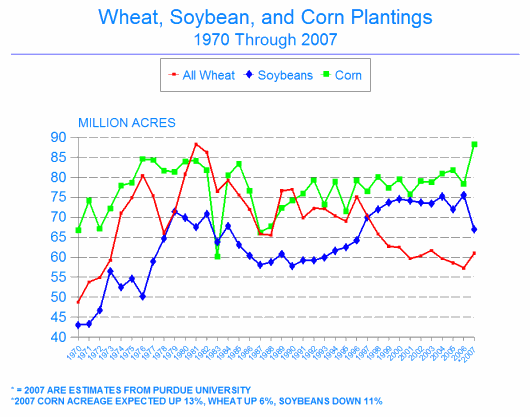
It is expected that U.S. corn acreage in 2007 will increase by 6-12 million acres, with the majority of that increase coming out of soybean acreage. With demand for biofuels likely to remain strong, these changes are likely to continue to unfold.
Wheat Basis
At our last Agricultural Advisory Committee Meeting we discussed a problem we were observing with weak basis and lack of convergence in some of the grain markets. The wheat basis has improved since the summer but the basis at some locations is still outside the normal range.
This was the picture from last July.
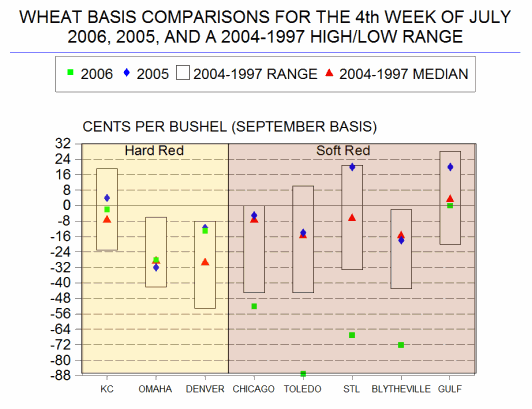
Not a good picture, the Toledo basis, for instance was 87 cents under the July.
Here is the same comparison for the February 2007 versus March 2007 basis.
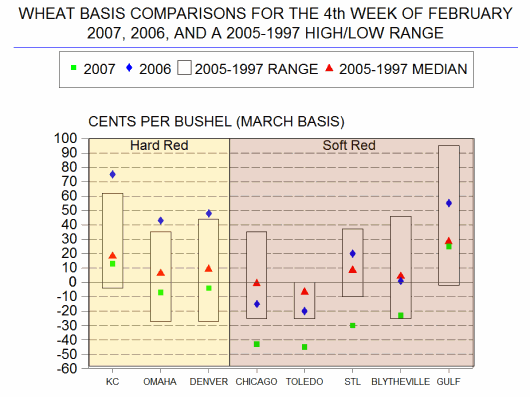
You can see that the basis has improved somewhat to 45 cents under the March price this year, but clearly there still is a concern.
On the other hand, corn and soybeans basis levels have both improved and are now in the normal ranges seen in previous years at all major locations.
This situation as led the CBOT to initiate a discussion of possible wheat contract changes. These changes include adjusting the contract to a shipping certificate from a registered warehouse receipt, raising storage rates, and tightening the allowable level of vomitoxin for deliverable grades.
One interesting issue that has been raised is whether the soft red wheat contract might be fulfilling a more global price discovery role, rather than simply reflecting domestic conditions. As markets become more global this could clearly become an issue that producers and processors need to be aware of.
If price discovery is expanding beyond traditional pricing factors, producers and processor are going to have some work to do to figure out how those prices relate to their operations.
As foreign countries increase grain production and exports, their influence on world prices has grown. U.S. futures markets, however, factor in these shifts and continue to be the primary benchmark for international pricing.
For example, in wheat, the U.S. accounts for only 8% of world production and 22% of world exports, yet 95% of all wheat futures volume is in the U.S. South America has surpassed the U.S. in soybean production and exports, but prices there, and across the globe, principally trade on the CBOT because of quantifiable transportation and exchange rate cost relationships.
Liquidity is a good thing, but it can be more difficult for a U.S. producer or processor to figure out exactly what the CBOT futures market is telling them. And, it can lead to persistent distortion in basis relationships to the extent the futures markets are pricing different factors from the cash markets.
This is an area the Commission needs to continue to take a serious look at.
Commitments of Traders—Update
One area where we have tried to improve the ability of producers and processors to interpret futures prices has been in expanding our Commitments of Traders reports. At the request of a number of agricultural groups and after a public comment period, the Commission began publishing additional data in its weekly COT report beginning the first of this year.
The Commission is now publishing a supplemental COT report that shows the positions of “Index Traders” separately from the Commercial and Noncommercial categories in 12 agricultural markets.
This segment of traders represents passive investors in commodities who invest to replicate a broad index of commodities. These “Index Traders” are not allowed to carry futures above the spec limits into the spot month.
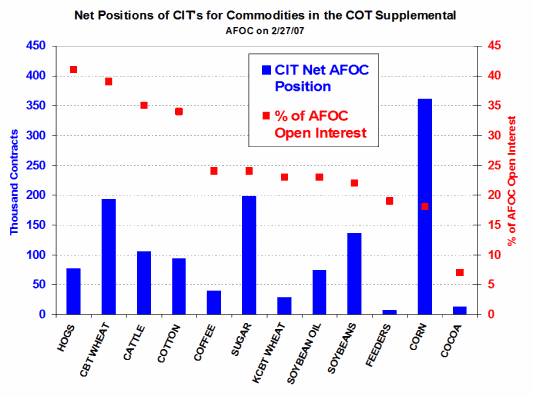
Index Traders have recently comprised anywhere from about 17% of the long side of the corn futures market to as high as 40% of the lean hog futures market.
As we published the first of the weekly supplemental reports, we also published a year’s worth historical data (all of 2006).
I consider these changes an ongoing process, and I encourage you to communicate any concerns, comments, or suggestions you have regarding our reporting.
Exemptions from Speculative Position Limits
Related to this topic, in its regulatory agenda, last fall, the Commission said that it would be publishing a notice of proposed rulemaking regarding amending Part 150 of its regulations to create an additional exemption from speculative position limits.
In the past year, the Commission has granted no-action relief to two index tracking funds, letting them exceed speculative limits even though their activities don’t meet the traditional definition of bona fide hedging under Commission Regulations.
The Commission has a long standing policy of allowing swaps dealers to qualify for speculative exemptions because a swap dealer is a “commercial” in the sense that they are taking on price risk related to the physical commodity underlying the swap.
Index tracking funds, however, as many of you have commented to the Commission, are taking on price risk related not to the price of the underlying commodity, but their obligation to their investors to produce a return by tracking an index of commodities.
In fact, many producers and processors have expressed concerns that long positions held by index traders are relatively price insensitive.
In the regulatory agenda, the Commission expressed its intention to examine the speculative exemption provisions and to consider how to address the role of index tracking funds in commodity markets.
I encourage you all to provide your input to the Commission as we consider this topic.
The agency publishes its regulatory agenda in the Federal Register twice a year in the Spring and Fall. While not binding, it sets out the regulatory issues that the Commission expects to take action on in the upcoming year. If you have an issue that you would like to see the Commission address that is not on the agenda, please let me know.
Reauthorization
A big issue for us in Congress is reauthorization. As you know, the Commission is still awaiting completion of its reauthorization bill. And it looks like we could be waiting awhile.
In getting finished, CEA reauthorization faces stiff competition from Farm Bill reauthorization, which is also up this Congress. Following the recent switch of majorities in Congress, the House and Senate Agriculture Committees are still considering how to move forward on CEA reauthorization. So, it is an open question when, or if, CEA reauthorization will start moving this year.
I have thought that, if CEA reauthorization is going to be in competition with the Farm Bill, perhaps, it ought to be included as a title in the Farm Bill. Given some of the contentious issues involved with reauthorization, it might be the only way to get CEA reauthorization done.
Issues such as regulation of over-the-counter energy products and the retail sale of foreign-exchange or Forex contracts could make it very difficult to get a stand-alone bill through Congress.
Given the critical nature of energy as a commodity, recent high prices and scandals affecting the energy sector have brought renewed attention to energy markets. I think the Federal Government’s central mission should be to make sure that energy markets are as transparent and resistant to manipulation and fraud as possible. Given the complexity of our existing markets, there is no easy answer for accomplishing this.
One of the biggest questions the public has is why have energy prices been so high recently, even though they have retreated somewhat in recent months? Well, of course, it is a tough question to answer definitively why the price in a market is what it is. Breaking down the fundamentals of a market is as much art as science. One person’s market fundamentals may be another’s speculative excess.
While I think it would be valuable for the Commission to formally study what, if any, effect the large influx of speculative money has had on trends in commodity markets, it would be quite difficult, if not impossible, to define at what point an influx of open interest, for instance from index tracking funds, created conditions that led to “unreasonable fluctuations” or “unwarranted changes” in price. The Commission is not in a position to pick among different economic uses of a particular futures contract and decide which are to be discouraged or encouraged.
I think the key thing is to make sure there is sufficient openness and transparency so the Commission or someone can make sure a market is functioning fairly and efficiently. The Commission does that for energy commodities traded on a designated contract market. Through our commitments of traders reports we can even pass some of that information back to the public.
From this standpoint, U.S. markets set the world standard for transparency. No other country offers anything similar.
However, a large portion of energy trading occurs in the over-the-counter market, mostly beyond the scrutiny of any federal agency. The Commission’s enforcement actions continue to uncover repeated examples of people and companies trying to game the energy markets, often in the belief that no one is watching, or that if someone is, there is nothing that can be done to them.
Most of the energy cases we file affect narrow segments of the industry, and each one individually probably does not have a large impact on consumers overall. However, each of these cases calls into question the integrity of the energy markets they involve, and as Enron showed, there can be large consequences for consumers in the biggest cases. At the end of the day, there really is no intelligible reason why energy products traded on a designated contract market are scrutinized for fraud and manipulation, while the virtually identical products traded on an exempt electronic exchange receive no scrutiny.
I think Congress needs to consider whether the integrity and transparency of energy markets need to be bolstered. Certainly those markets have changed a great deal since deregulation began in the 1990s. Because no one conducts regular surveillance of the overall energy market, it is virtually impossible to know the extent of fraud and manipulation that may be occurring in the over-the-counter markets. The Commission has broad authority to request information, after the fact, if we become aware that someone may have committed false reporting or attempted to manipulate prices in the OTC markets. But there is no “cop on the beat” regularly looking for misconduct in the OTC markets.
I think it is important that Congress consider whether there should be increased oversight of OTC markets that fulfill a price discovery function for energy. It is from these markets that we have seen most of our energy-related enforcement cases arise, and that are most likely to affect consumers when there are problems.
Another issue that will be addressed in reauthorization is fixing the so-called Zelener loophole. That loophole follows from a case, CFTC v. Zelener, in which the 7th Circuit Court of Appeals found the CFTC had no jurisdiction over retail forex contracts known as “rolling spots.” These contracts, on their face, are written as spot contracts. However, in practice, delivery never occurs, and they are rolled over into a new contract as they expire. The logic of the 7th Circuit has been adopted by courts in Ohio and Florida (the 6th and 11th Circuits respectively), and will very likely spread to others. There is nothing about the “rolling spot” contract that limits itself to foreign exchange. These contracts could very easily be used in other commodities. The current language of both the House and Senate reauthorization bills would only fix the Zelener problem for Forex.
Given the ingenuity of criminals committing commodities fraud that I have seen during my tenure, I think it is better to close doors that might lead to trouble as soon as possible, rather than waiting to see who comes in. As the Zelener loophole becomes adopted by more and more courts, I become more and more worried about closing that loophole only for forex. I think it paints a bullseye for where criminals will go next.
Both of these issues will be discussed during reauthorization, and I think the debate will be helpful in making sure we maintain a balance between fostering innovation and competition in the industry, and making sure that the public is protected, as best we can, against fraud and deceit.
AAC
I’d like to turn now to future plans for the Agriculture Advisory Committee. There are a lot of exciting issues to dig into. The globalization of commodity markets could clearly have an impact upon agricultural commodity markets. If, for instance, the liquidity for one of our major grain exchanges were to shift to an overseas market, what would the consequences of that be? Are there changes that need to be made to ensure that U.S. exchanges are on a level regulatory playing field with foreign exchanges?
These are all questions that I would like to address within the context of the Agricultural Advisory Committee.
Other issues that I would like to cover in upcoming meetings include reviewing the impact of last year’s speculative limits increase of 2005, hedge to arrive contracts, and agricultural trade options. I would also like to look at some emerging markets that could have impacts for the agricultural world, such as the ethanol and carbon markets.
Lastly, I would like to consider whether the Commission needs to update its regulations for granting hedge exemptions for non-traditional hedgers. Recently, I had concerns about the granting of no-action relief to two firms seeking relief from the Commission’s speculative position limits. While I do not necessarily disagree with granting such relief, I believe those types of policy decisions should be made by the Commission through a public process to amend its rules, not ad-hoc staff letters to the industry.
I have concerns about the use of the no-action process generally, but, in addition, the area of speculative position limits in agricultural commodities is one of keen interest for the users of agricultural markets. In 2005, the Commission considered revising or doing away with speculative position limits for agricultural commodities. In the face of concern from agricultural producers, the Commission ultimately decided to retain the limits, but did implement significant increases. I hope that we can undertake a similar process for revising speculative limit exemptions as well.
As always, I welcome any thoughts all of you might have for topics for future meetings. My goal is to make the Ag. Advisory Committee as relevant as possible to its members.
Resources
Lastly, I would like to make some comments about the Commission’s budget situation.
During the past 10 years, as can be seen in this slide, trading volume on U.S. futures exchanges has quintupled. Today, in a single day of trading, our markets will move more than $5 trillion dollars. The industry has grown from standard agricultural product hedging to a broad array of complex instruments related to both physical and financial products. Trading volume, measured by numbers of contracts traded has more than tripled in the past six years. At the same time, Commission staffing levels have fallen to 458 full time employees on board today. This compares with the 497 FTEs used 30 years ago in 1976, the Commission’s first year of operation. Commission employees work hard, work smarter, and use technology effectively, but given the complexity of the markets we oversee, we are stretched to the limit.
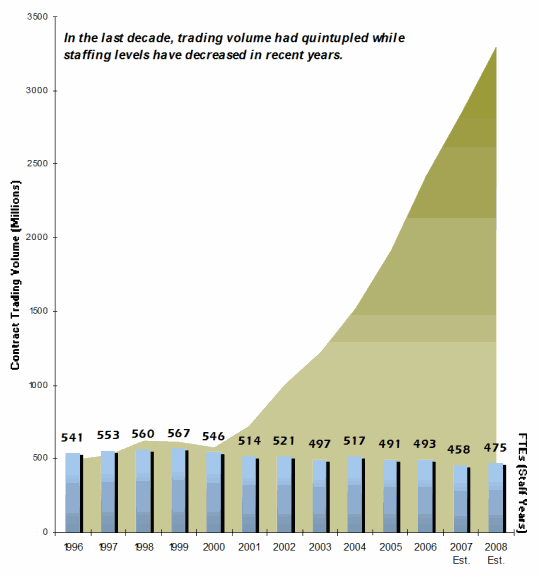
Figure 1: Growth of Volume of Contracts Traded and FTEs
This year, President Bush has requested $116 million for fiscal year 2008 funding for the Commission. If Congress approves this level of funding this will allow the Commission to address its two major needs – staff increases and technology investment.
I wholeheartedly support the President’s request, and hope that Congress will approve it.
I want to thank you for your time and I am happy to take any questions.
Last Updated: June 10, 2010
